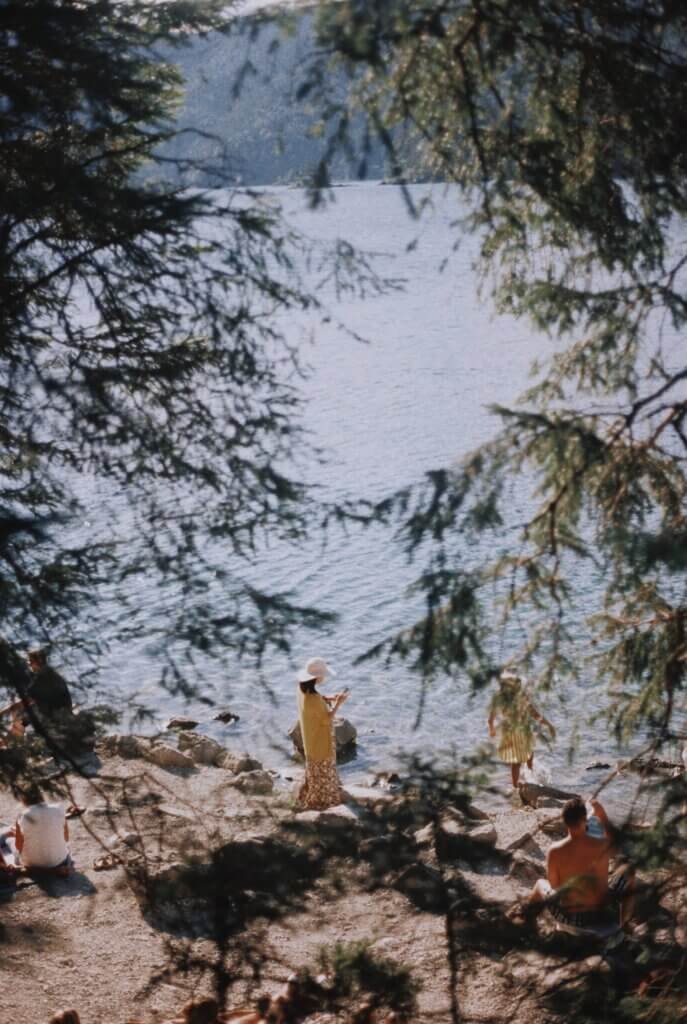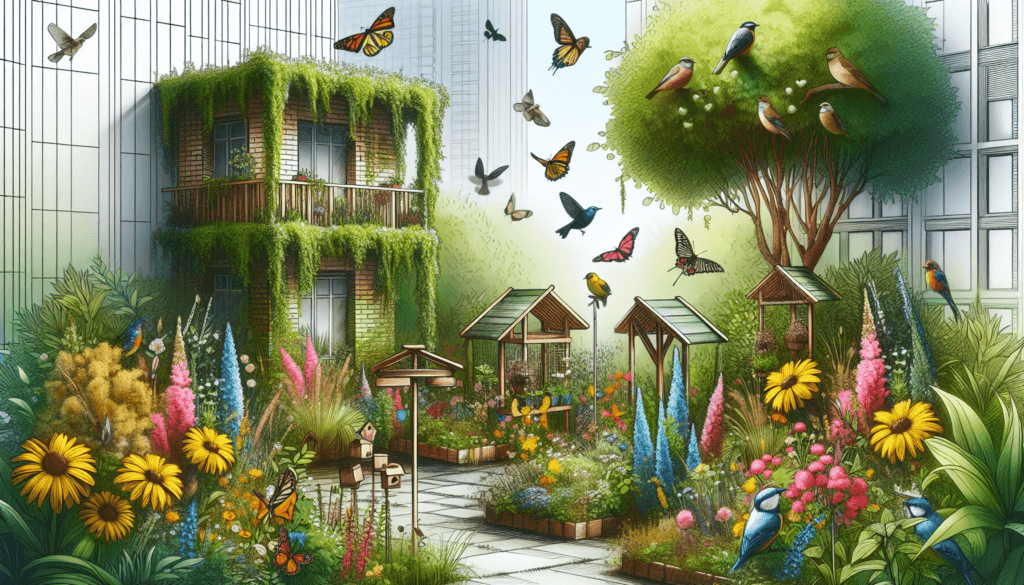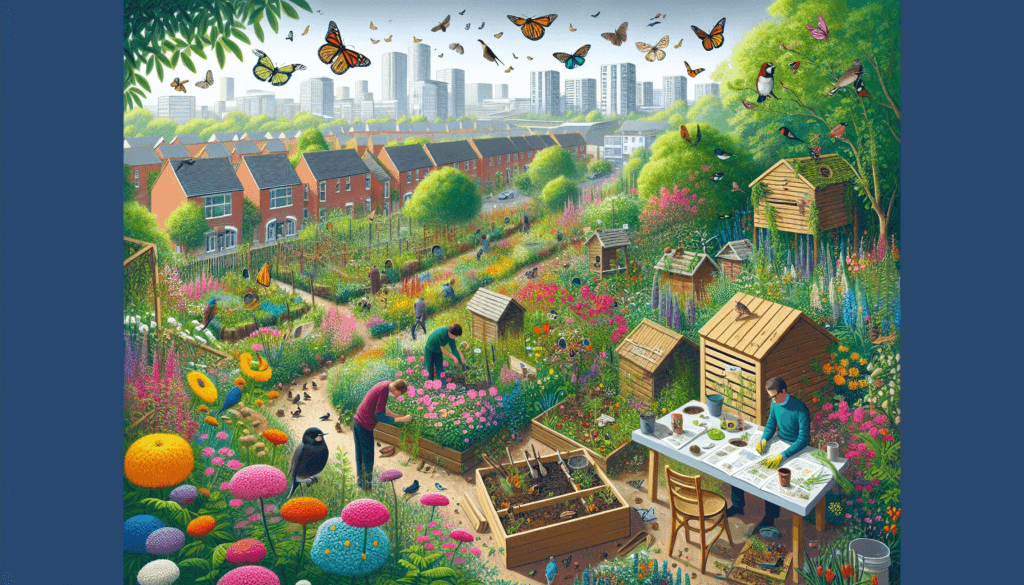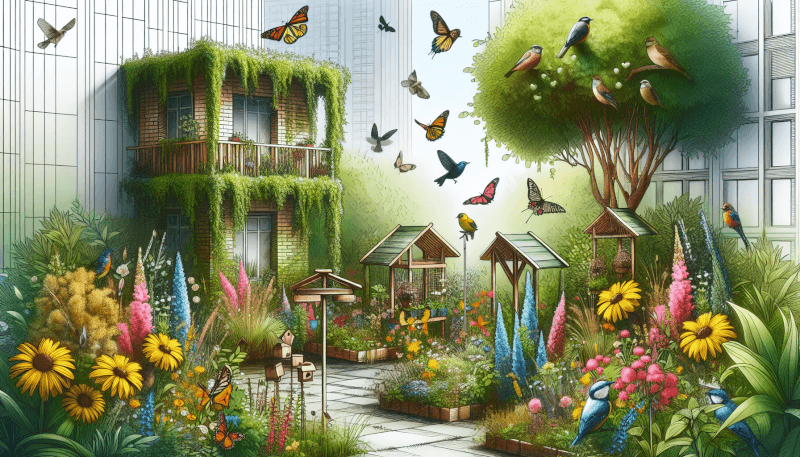Transform your urban garden into a thriving haven for wildlife with “The Essential Guide To Creating A Wildlife-Friendly Urban Garden.” In this comprehensive guide, you will discover practical tips, expert advice, and creative ideas to attract and support a diverse range of wildlife species in your very own backyard. From choosing the right plants and designing wildlife-friendly features to understanding the importance of water sources and creating habitats, this guide will empower you to make a positive impact on local ecosystems while enjoying the beauty of nature right on your doorstep. Get ready to welcome a vibrant array of birds, butterflies, bees, and more as you embark on this exciting journey to create a wildlife-friendly urban garden.
Choosing Native Plants
The Importance of Native Plants
When creating a wildlife-friendly garden, one of the most crucial aspects to consider is the use of native plants. Native plants are plants that naturally occur in a specific region and have adapted to the local soil, climate, and wildlife over time. By incorporating native plants into your garden, you provide essential food, shelter, and habitat for local wildlife species. They attract pollinators like bees and butterflies, provide nectar and seeds for birds, and create a balanced ecosystem that supports the entire food chain. Additionally, native plants are often low-maintenance and require fewer resources such as water and fertilizer, making them an environmentally sustainable choice.
Researching Native Plants for Your Area
Before selecting native plants for your garden, it’s essential to conduct thorough research to ensure you choose species that are well-suited to your specific area. Consider the local climate, soil conditions, and the types of wildlife you wish to attract. Visit your local nursery or consult with a horticulturist or botanist to get recommendations on native plants that thrive in your region. You can also refer to online resources and field guides that provide detailed information on native plants and their benefits. By carefully selecting the right native plants for your garden, you can create an environment that supports a diverse range of wildlife species.
Creating a Native Plant Palette
Once you have conducted your research, it’s time to create a native plant palette for your garden. A native plant palette refers to a carefully curated selection of native plants that will form the foundation of your wildlife-friendly garden. When designing your plant palette, consider incorporating a variety of plants that offer different wildlife benefits throughout the year. Choose a mix of flowering plants, shrubs, grasses, and trees that provide food sources, nesting opportunities, and shelter for various wildlife species. By creating a diverse and well-balanced plant palette, you can attract a wide range of birds, butterflies, bees, and other beneficial insects to your garden.
Providing Food Sources
Planting Native Trees and Shrubs
Planting native trees and shrubs is an excellent way to provide a consistent source of food for wildlife in your garden. Trees like oaks, hickories, and maples produce nuts and acorns that are a valuable food source for many birds and small mammals. Shrubs such as elderberries, serviceberries, and viburnums offer nutritious berries that attract birds, including migratory species. When selecting trees and shrubs, consider planting a mix of species that flower at different times of the year to ensure a constant supply of nectar and pollen for pollinators.
Including Wildflowers and Perennials
Wildflowers and perennials are not only beautiful additions to a garden but also play a crucial role in providing food for wildlife. Choose native wildflowers that produce nectar-rich blooms, such as milkweed for monarch butterflies or purple coneflower for bees. Perennials like asters, goldenrods, and black-eyed Susans offer valuable late-season nectar when other food sources may be scarce. By including a variety of wildflowers and perennials in your garden, you can attract a wide array of pollinators and provide much-needed sustenance throughout the year.
Growing Fruiting Plants
Fruiting plants are a fantastic way to provide food for wildlife, especially birds. Consider planting native fruit-bearing trees and shrubs like dogwoods, chokeberries, and mulberries. These plants produce berries that attract a wide range of bird species, offering them a crucial food source while also enhancing the beauty of your garden. Additionally, fruiting plants can provide a winter food source when other natural food options may be limited. By growing fruiting plants, you create a vibrant and engaging habitat that will entice an abundance of wildlife.

Creating Shelter
Incorporating Trees and Bushes for Nesting
Shelter is an essential component of a wildlife-friendly garden, providing a safe place for animals to rest, hide, and nest. Incorporating trees and bushes that offer dense foliage, such as evergreens, provides shelter for birds and small mammals. They also act as protective cover during inclement weather and provide nesting sites for birds. Select native species that offer multiple layers of foliage, as this will attract a wider variety of wildlife. By creating a diverse range of shelter options, you ensure that your garden becomes a welcoming sanctuary for local wildlife.
Building Brush Piles and Rockeries
Brush piles and rockeries are simple yet effective ways to create additional shelter in your garden. Gather branches, logs, and natural debris, and create piles in a secluded corner of your garden. These brush piles mimic the natural habitat structure of fallen logs and leaf litter, attracting insects, reptiles, and small mammals. Similarly, rockeries made from stacked stones provide crevices and hiding places for reptiles and other small animals. By incorporating these features, you offer additional shelter options for wildlife, encouraging them to settle and thrive in your garden.
Setting Up Bird and Bat Houses
Birdhouses and bat houses are a great way to provide additional nesting opportunities for these flying creatures. Select birdhouses that match the needs of the bird species in your area, considering factors such as nest box size and entry hole diameter. Make sure to place the birdhouses at a suitable height and location, away from potential predators and in a spot that offers some shade and protection. Similarly, bat houses should be strategically placed to attract bats and provide a safe roosting spot. By setting up these houses, you can actively support and encourage nesting behaviors in birds and bats, enhancing the biodiversity of your garden.
Installing Water Features
Ponds and Water Gardens
Water features like ponds and water gardens not only add beauty to your garden but also provide a vital water source for wildlife. Ensure that your water feature has sloping sides to allow animals to access the water easily. Adding rocks and plants at different depths provides areas for amphibians, insects, and birds to perch and drink. Including floating plants like water lilies not only provides shade but also creates hiding places for fish and other aquatic life. By incorporating a pond or water garden, you attract a wide range of wildlife, from frogs and dragonflies to birds and small mammals.
Bird Baths and Water Drippers
Bird baths are a simple yet effective way to provide a water source for birds in your garden. Choose a shallow and sturdy bird bath, preferably with textured surfaces for birds to grip. Place the bird bath in a quiet and shady spot, away from potential predators. It’s crucial to regularly clean and refill the bird bath to prevent the spread of diseases. Additionally, consider installing a water dripper or mister near the bird bath to create a dripping or misting effect, which birds are naturally drawn to. By providing clean and accessible water, you make your garden a haven for birds to drink, bathe, and cool off.
Rain Barrels
Installing rain barrels in your garden not only helps conserve water but also provides a supplemental water source for wildlife. Collecting rainwater runoff from rooftops allows you to supply water to plants, animals, and insects during dry periods. Place the rain barrels strategically in your garden, ensuring they are secure and stable. You can use the collected rainwater to fill bird baths, water drippers, or even create small puddling areas for butterflies and other insects. By using rain barrels, you can actively contribute to water conservation efforts while creating a reliable water source for local wildlife.

Creating Habitat for Insects
Planting for Pollinators
Insects play a crucial role in a garden’s ecosystem, especially as pollinators. By planting a variety of native plants that produce abundant nectar and pollen, you can attract pollinators such as bees, butterflies, and even beetles. Choose plants with different bloom times throughout the year to provide a continuous food source. Native wildflowers like lavender, coneflower, and bee balm are excellent choices for attracting pollinators. Avoid using pesticides, as they can harm beneficial insects. By creating a pollinator-friendly garden, you contribute to the health of local ecosystems and ensure the pollination of flowering plants.
Building Insect Hotels and Bee Boxes
Insect hotels and bee boxes are simple structures that offer nesting sites and shelter for beneficial insects. They consist of various materials like hollow stems, logs with drilled holes, and pieces of wood with cracks and crevices. These structures attract solitary bees, ladybugs, lacewings, and other insects that provide natural pest control and pollination services. Place the insect hotels and bee boxes in a sunny and sheltered location, preferably near flowering plants. By building these habitats, you welcome a diverse range of beneficial insects into your garden, helping to maintain a balanced and thriving ecosystem.
Leaving Fallen Logs and Leaves
Leaving fallen logs and leaves undisturbed in your garden may seem unconventional, but it provides crucial habitat for a variety of insects and small animals. Fallen logs provide shelter for beetles, centipedes, and wood-boring insects. They also slowly break down over time, enriching the soil and creating a diverse microhabitat. Similarly, leaving a layer of fallen leaves on the ground creates a perfect habitat for insects like ground beetles and spiders. These insects feed on pests and act as natural pest control agents. By embracing the natural decay process in your garden, you promote biodiversity and support important ecological interactions.
Avoiding Chemicals
Using Organic Pest Control Methods
Chemical pesticides and fertilizers can have detrimental effects on wildlife and the environment. Instead, opt for organic pest control methods to manage pests in your garden. Implement cultural practices like crop rotation, companion planting, and proper irrigation to prevent pest problems. Encourage natural pest predators like ladybugs, praying mantises, and birds by creating a diverse and wildlife-friendly garden. Additionally, handpicking pests or using organic insecticidal soaps and oils can effectively control pests without harming beneficial insects. By avoiding chemical pesticides, you create a safe and healthy environment for both wildlife and humans.
Eliminating Synthetic Fertilizers and Pesticides
Synthetic fertilizers and pesticides are often used to enhance plant growth and control pests, but they can have harmful effects on wildlife and soil health. Instead, focus on building healthy soil by incorporating organic matter, compost, and natural amendments. Use organic fertilizers like worm castings or well-rotted manure to provide essential nutrients to your plants. By eliminating synthetic fertilizers and pesticides, you minimize the risk of contaminating water sources and protect beneficial insects, birds, and other wildlife.
Promoting Natural Pest Predators
One of the keys to creating a wildlife-friendly garden is to promote natural pest control by attracting and supporting natural pest predators. Birds, bats, ladybugs, and spiders are just a few examples of beneficial creatures that can help keep pest populations in check. Planting a diverse range of trees, shrubs, and flowers provides food and shelter for these predators, ensuring they remain in your garden. Creating a balanced ecosystem where pest populations are naturally regulated by predators reduces the need for harmful pesticides and fosters a harmonious relationship between wildlife and your plants.

Designing for Wildlife
Creating Diverse Layers and Heights
When designing your wildlife-friendly garden, aim to create diverse layers and heights throughout your landscape. Incorporate tall trees, medium-sized shrubs, and low-growing groundcovers to provide different levels of shelter, nesting opportunities, and food sources. Trees create a canopy for perching and nesting birds, while shrubs offer protective cover for small mammals and nesting sites for birds. Groundcovers attract a variety of insects and act as a buffer for the soil. By including a mixture of layers and heights, you create a visually appealing garden while providing habitat for a wide range of wildlife species.
Including Open Spaces and Meadow Areas
While it is important to have dense vegetation for shelter, incorporating open spaces and meadow areas is equally crucial. Open spaces allow for free movement of larger wildlife like rabbits, foxes, or even deer. Meadows provide valuable forage for grazing mammals and attract a diverse array of insects and pollinators. Consider planting native grasses and wildflowers in designated meadow areas to cultivate a natural and low-maintenance habitat. By incorporating open spaces and meadows, you create a dynamic and multifaceted garden that caters to the needs of both small and large wildlife species.
Designing with Consideration for Animal Pathways
When designing your wildlife-friendly garden, it’s important to take into account the natural pathways and migration routes of animals in your area. Being mindful of existing animal paths ensures that your garden becomes part of a seamless network of habitats, allowing wildlife to move freely and access essential resources. Avoid obstructing or blocking these pathways and consider incorporating features like stepping stones or gravel paths to guide animals through your garden. By designing with consideration for animal pathways, you contribute to the connectivity of wildlife habitats and promote a healthy and diverse ecosystem.
Providing Nesting Opportunities
Building Nesting Boxes for Birds
Bird nesting boxes, also known as birdhouses, are an excellent way to provide nesting opportunities for cavity-nesting species. Different bird species have specific requirements for nest box design, including hole size, height, and placement. Research the nesting requirements of the bird species in your area and select appropriate nest box designs. Place the nest boxes in suitable locations, preferably facing away from prevailing winds and protected from potential predators. By providing nesting boxes, you create safe and secure spaces for birds to raise their young, contributing to the overall vitality of the bird population in your garden.
Creating Rock Piles and Slopes for Reptiles
Reptiles, such as lizards and snakes, benefit from specific nesting habitats that include rock piles and slopes. Create a pile of rocks with crevices and spaces for reptiles to seek shelter and lay their eggs. Ensure that the rocks are stable and provide safe hiding places. Additionally, consider incorporating gentle slopes or terraced areas in your garden to mimic natural reptile nesting sites. By creating suitable nesting opportunities for reptiles, you add another layer of biodiversity to your garden and support the sustainability of these important and often misunderstood creatures.
Planting Vines and Climbers for Nesting
Vines and climbers offer nesting opportunities for a variety of bird species, as well as providing shelter and creating vertical interest in your garden. Consider planting native vines like Virginia creeper, trumpet vine, or honeysuckle along fences or trellises. These plants produce dense foliage that acts as a protective cover and nest-building material for birds. Vines with berries or flowers like clematis and wisteria also attract pollinators and fruit-eating birds. By incorporating vines and climbers, you provide nesting options for birds and enhance the overall aesthetic appeal of your garden.

Maintaining a Water Source
Keeping Birdbaths Clean and Refilled
To ensure the health and safety of birds, it’s important to regularly clean and refill your birdbaths. Standing water can quickly become a breeding ground for bacteria and mosquitoes, so it’s crucial to empty, scrub, and refill the birdbaths at least once a week. Use a mild solution of water and vinegar or a bird-safe cleaner to remove any algae or dirt. Refill the birdbaths with fresh, clean water to provide a reliable water source for birds to drink and bathe. By maintaining clean and hygienic birdbaths, you create a welcoming and safe space for birds to enjoy.
Preventing Water Accumulation in Containers
While water features are beneficial for wildlife, it’s important to prevent water accumulation in containers that may not be intended as water sources. Items like buckets, pots, or discarded containers can collect rainwater and become breeding grounds for mosquitoes. Regularly empty and overturn any containers that can collect water to prevent the spread of diseases and pests. By removing potential breeding sites, you ensure the health and well-being of wildlife in your garden.
Monitoring Water Quality
Regularly monitoring the quality of water in your garden is essential to maintain a healthy ecosystem. Conduct simple water quality tests to ensure that the water in ponds, birdbaths, or other water features is free from harmful chemicals or pollutants. Avoid using pesticides or chemical cleaners near water sources, as they can contaminate the water and harm wildlife. By monitoring water quality and taking appropriate steps to maintain cleanliness, you create a safe and thriving environment for the wildlife in your garden.
Educating and Engaging Others
Sharing Your Garden with Others
One of the most rewarding aspects of creating a wildlife-friendly garden is sharing it with others. Invite friends, family, and neighbors to experience the beauty and biodiversity of your garden. Share stories about the wildlife you have observed and the ecological benefits your garden provides. Encourage others to create their wildlife-friendly spaces by providing them with information and resources. By sharing your garden with others, you inspire and educate them about the importance of wildlife conservation and the role each person can play in creating a sustainable and harmonious environment.
Hosting Educational Workshops and Events
Consider hosting educational workshops and events in your garden to further promote wildlife conservation and sustainable gardening practices. Invite local experts or organizations to conduct workshops on topics such as native plant gardening, bird identification, or beneficial insect habitat creation. Arrange tours of your garden to highlight specific features and explain their ecological significance. These events create opportunities for community engagement and learning while spreading awareness about the importance of wildlife-friendly gardening practices.
Joining Local Wildlife Conservation Initiatives
To make a broader impact in wildlife conservation, consider joining local wildlife conservation initiatives or organizations. Connect with like-minded individuals in your community who share a passion for preserving and enhancing local ecosystems. Collaborate on projects, such as creating communal wildlife corridors or establishing community gardens that serve as wildlife habitats. By actively participating in conservation initiatives, you become part of a collective effort to protect and restore biodiversity, not just in your garden but throughout your entire community.
In conclusion, creating a wildlife-friendly garden is a rewarding and impactful endeavor. By choosing native plants, providing food sources, creating shelter, installing water features, promoting habitat for insects, avoiding chemicals, designing with consideration for wildlife, providing nesting opportunities, maintaining a water source, and educating and engaging others, you can transform your garden into a thriving sanctuary for a wide range of wildlife species. Embrace the beauty and wonder of nature by creating a vibrant and sustainable environment that supports and conserves local biodiversity.



